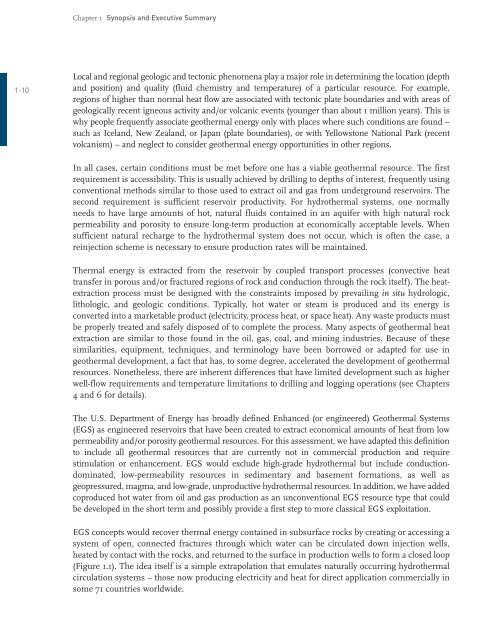The Future of Geothermal Energy – Impact of Enhanced ... - EERE
The Future of Geothermal Energy – Impact of Enhanced ... - EERE
The Future of Geothermal Energy – Impact of Enhanced ... - EERE
Create successful ePaper yourself
Turn your PDF publications into a flip-book with our unique Google optimized e-Paper software.
Chapter 1 Synopsis and Executive Summary<br />
Local and regional geologic and tectonic phenomena play a major role in determining the location (depth<br />
110 and position) and quality (fluid chemistry and temperature) <strong>of</strong> a particular resource. For example,<br />
regions <strong>of</strong> higher than normal heat flow are associated with tectonic plate boundaries and with areas <strong>of</strong><br />
geologically recent igneous activity and/or volcanic events (younger than about 1 million years). This is<br />
why people frequently associate geothermal energy only with places where such conditions are found –<br />
such as Iceland, New Zealand, or Japan (plate boundaries), or with Yellowstone National Park (recent<br />
volcanism) – and neglect to consider geothermal energy opportunities in other regions.<br />
In all cases, certain conditions must be met before one has a viable geothermal resource. <strong>The</strong> first<br />
requirement is accessibility. This is usually achieved by drilling to depths <strong>of</strong> interest, frequently using<br />
conventional methods similar to those used to extract oil and gas from underground reservoirs. <strong>The</strong><br />
second requirement is sufficient reservoir productivity. For hydrothermal systems, one normally<br />
needs to have large amounts <strong>of</strong> hot, natural fluids contained in an aquifer with high natural rock<br />
permeability and porosity to ensure longterm production at economically acceptable levels. When<br />
sufficient natural recharge to the hydrothermal system does not occur, which is <strong>of</strong>ten the case, a<br />
reinjection scheme is necessary to ensure production rates will be maintained.<br />
<strong>The</strong>rmal energy is extracted from the reservoir by coupled transport processes (convective heat<br />
transfer in porous and/or fractured regions <strong>of</strong> rock and conduction through the rock itself ). <strong>The</strong> heatextraction<br />
process must be designed with the constraints imposed by prevailing in situ hydrologic,<br />
lithologic, and geologic conditions. Typically, hot water or steam is produced and its energy is<br />
converted into a marketable product (electricity, process heat, or space heat). Any waste products must<br />
be properly treated and safely disposed <strong>of</strong> to complete the process. Many aspects <strong>of</strong> geothermal heat<br />
extraction are similar to those found in the oil, gas, coal, and mining industries. Because <strong>of</strong> these<br />
similarities, equipment, techniques, and terminology have been borrowed or adapted for use in<br />
geothermal development, a fact that has, to some degree, accelerated the development <strong>of</strong> geothermal<br />
resources. Nonetheless, there are inherent differences that have limited development such as higher<br />
wellflow requirements and temperature limitations to drilling and logging operations (see Chapters<br />
4 and 6 for details).<br />
<strong>The</strong> U.S. Department <strong>of</strong> <strong>Energy</strong> has broadly defined <strong>Enhanced</strong> (or engineered) <strong>Geothermal</strong> Systems<br />
(EGS) as engineered reservoirs that have been created to extract economical amounts <strong>of</strong> heat from low<br />
permeability and/or porosity geothermal resources. For this assessment, we have adapted this definition<br />
to include all geothermal resources that are currently not in commercial production and require<br />
stimulation or enhancement. EGS would exclude highgrade hydrothermal but include conductiondominated,<br />
lowpermeability resources in sedimentary and basement formations, as well as<br />
geopressured, magma, and lowgrade, unproductive hydrothermal resources. In addition, we have added<br />
coproduced hot water from oil and gas production as an unconventional EGS resource type that could<br />
be developed in the short term and possibly provide a first step to more classical EGS exploitation.<br />
EGS concepts would recover thermal energy contained in subsurface rocks by creating or accessing a<br />
system <strong>of</strong> open, connected fractures through which water can be circulated down injection wells,<br />
heated by contact with the rocks, and returned to the surface in production wells to form a closed loop<br />
(Figure 1.1). <strong>The</strong> idea itself is a simple extrapolation that emulates naturally occurring hydrothermal<br />
circulation systems – those now producing electricity and heat for direct application commercially in<br />
some 71 countries worldwide.

















